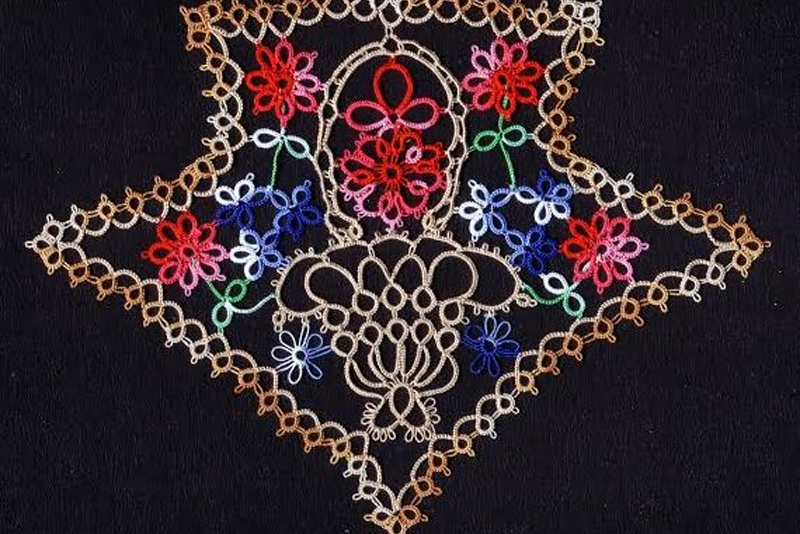Spring, summer, and fall are good seasons to hold homespun gatherings called reenactments. On many an old battlefield or famous location, like-minded persons gather to preserve our heritage and the trades and arts that helped to build the nation. While battle reenactments are stirring, those persons who demonstrate the old ways of spinning, weaving, basket-making, butter-making, quilting and, of course, tatting, I feel have the most lasting effect on the onlookers.
It is difficult to stay within the bounds of the time period even for tatters. For example, if a lacemaker wanted to demonstrate lacemaking during the early 1800's, then the lacer should show bobbin lace in progress. Here is a lace pillow dressed by Sherry Townsend.

After 1850 tatting is taking hold and publications with patterns appear, but it would be simple one shuttle tatting or tatting done using a blunt needle as if it were a shuttle.

You can tell that a needle was used as a shuttle in the doily below if you look carefully at the bare thread which goes between the rings; a shuttle would have been too big to go through the opening of a picot as shown here.

For excellent patterns to use at reenactments please see the Mlle Riego Books [url]http://www.bellaonline.com/articles/art70461.asp[/url]
"Flitting Fingers: Tatting in the 19th Century by Virgina Mescher
Virgina Mescher will be familiar to those BellaOnline.com tatters who are also members of the Online Tatting Class from her article on Civil War Tatting. Her book is a real gem for tatters, tatting historians, and tatters who participate in historical reenactments alike. Petite in size (8.5" x 5.5" or 21 x 14 cm), it is immense in the scope of information contained. It has 120 pages and contains an 8-page bibliography.
This fascinating look at tatting offers many 19th century instructions and patterns Metternich Cravat by Mlle. Riego(1842 - 1889.) Each pattern is fully documented with source and date. Many historical references to tatting and its origins are included.

The many types of tatting tools, needles, and shuttles are discussed and a list of tatting patents appears in the bibliography. This book fills a niche in the history of tatting. It is a great read and should be in every library!
I acquired this book as well as the above mentioned Reigo books for my personal tatting reference library. G. SeitzHere's the latest article from the Tatting site at BellaOnline.com.
A Tatter's Workbook This is a homemade notebook of tatting patterns which was edited by Jules & Kaethe Kliot, LACIS Pubs. It has 112 pages of simple tatting patterns in glorious color.
http://www.bellaonline.com/articles/art3420.asp
Please visit tatting.bellaonline.com for even more great content about Tatting. To participate in free, fun online discussions, this site has a community forum all about Tatting located here -
http://forums.bellaonline.com/ubbthreads.php?ubb=postlist&Board=39
I hope to hear from you sometime soon, either in the forum or in response to this email message. I thrive on your feedback! Have fun passing this message along to family and friends, because we all love free knowledge!
Georgia Seitz, Tatting Editor
http://tatting.bellaonline.com
One of hundreds of sites at BellaOnline.com







